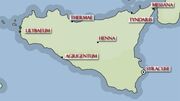
Map of Roman Sicilia.
Sicilia, or Sicily, is a large island off the southwestern coast of the Italian peninsula. Inhabited since prehistoric times, Sicilia was colonized by the Phoenicians beginning in the eleventh century B.C., and by the Greeks in the eighth century B.C. One of the most fertile areas of the Mediterranean, the Greek colony of Syracuse became one of the wealthiest Greek city-states, while the Phoenician colonies in western Sicilia developed as trade ports. As the Greek city-states in eastern Sicilia expanded to the west, they came in conflict with Carthage, leading to two centuries of almost constant war. Carthage achieved the upper hand, taking control of most of the island, but came in turn into conflict with the Roman Republic as Rome secured control of the Greek colonies on the southern coast of the Italian peninsula. As Carthage maneuvered to dominate Syracuse and achieve complete control of the island, Rome in 264 B.C. declared war, leading to the First Punic War between Carthage and the Roman Republic
The war, lasting 20 years, led to the development of a Roman navy organized around the principle of boarding actions rather than the battles of maneuver to which the Greeks and Carthaginians had been accustomed. By turning naval battles into infantry battles, Rome seized a tactical advantage that Carthage proved unable to counter. Although Hannibal Barca's father, Hamilcar, in command of Carthaginian ground forces in Sicilia was able to thwart Roman troops on the ground, turning the war there into a stalemate, the mounting Roman victories at sea made continuation of the war untenable for Carthage. A peace was concluded calling for the Carthaginian evacuation of Sicilia, leaving Rome dominant on the island and Syracuse the only remaining independent city-state, albeit a politically dominated ally of Rome.
When Hamilcar's son, Hannibal, came of age he attempted to fulfill the Barca family oath of hatred of Rome by attacking Italy in 218 B.C., invading from Carthaginian-ruled Iberia, crossing the Alps and descending upon northern Italy. After Hannibal's crushing victory over the Roman legions at Cannae in 215 B.C., Syracuse broke its alliance with Rome and allied with Carthage. Roman legions occupying Sicilia defeated the Syracusan army in the field and commenced a two-year siege of the city itself, famously resisted by the ingenious devices of Archimedes, advisor to the king of Syracuse. In the end, though, Syracuse was taken by escalade, and Archimedes killed, according to legend, as he contemplated a geometry problem. The citadel of the city fell shortly afterward, and Roman rule of Sicilia was complete. Sicilia then became the launching site for the Roman invasion of North Africa, led by Publius Cornelius Scipio, forcing Hannibal's return from the Italian peninsula to organize the defense of Carthage itself. Upon the final defeat of Hannibal at Zama in 202 B.C., Sicilia's transformation into a Roman conquest was complete.
The Roman Republic administered Sicilia as a proconsular territory. The conquered territory was subject to military rule, and the lands auctioned off. These auctions, though, were politically compromised, and skewed by the immunity of senators to taxation. This gave rise to the latifundia system of large farms owned by members of the senatorial or equestrian classes, but worked entirely by slaves. Protest against the corruption of this system was led by the Gracchus brothers between 135 and 121 B.C., but both were killed as the result of mob violence orchestrated by those opposed to reform. Rome indeed capitalized on Sicilia's fertility, making Sicilia, until the conquest of Egypt, the major grain producer of the Republic. The latifundia system provided cheap grain to Rome, but put increasing pressure on the small farmers of the Italian peninsula, who had historically been the basis of the Roman Republic and its legions. Over time, farming in the Italian peninsula would be reorganized completely on the slave-based system which had proved so productive in Sicilia, undermining the stability of the Republic.
Sicilia was regarded by Roman citizens as a rustic backwater, and Rome made little effort to integrate Sicilia politically or socially into the Republic. Increasing Roman corruption and misrule of the island led to political scandals throughout the later days of the Republic, and led also to the first two Servile Wars, occurring from 135-132 B.C. and from 104-100 B.C., both of which were bloodily suppressed.
Notable Sicilians[]
- Leonidas Hieronymus
- Gaius Verres (Roman Governor)